
An asperity (is an area on a fault that is stuck or locked. In the Earth, tectonic earthquakes are caused by slip along a fault Earthquake Resources movement involves slip on one or more asperities, or “stuck patches” where the friction is highest. Most of the energy that is released by earthquakes comes from the patches that become “unstuck.
Scrap lumber, raw spaghetti, and a ratcheting bar-clamp can be combined to create a physical model of asperities on a fault. In the model the wood represents the fault, the spaghetti represent asperities or stuck patches on the fault, and squeezing the clamp represents tectonic forces. As you slowly apply stress with the clamp, a few spaghetti strands may break (foreshocks) a few seconds prior to many strands breaking in rapid succession (mainshock). This event may be followed by a few remaining strands breaking (aftershocks).
Students will be able to:
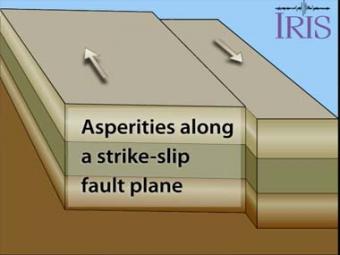
An asperity is an area on a fault that is stuck or locked. Scientists study areas along long fault zones that have not had earthquakes in a long time in order to determine where the next earthquake may occur. As long faults move, all areas of it will, at some point, become "unstuck" causing an earthquake relative to the the size of the asperity that finally breaks.
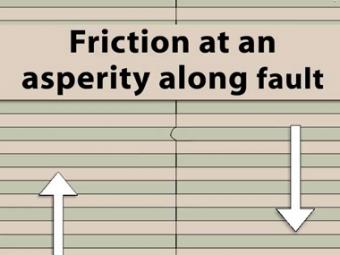
View looking into a fault zone with a single asperity. Regional right lateral strain puts stress on the fault zone. A single asperity resists movement of the green line which deforms before finally rupturing.
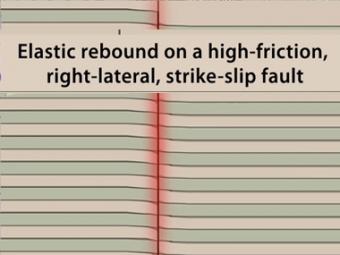
Animation shows the buildup of stress along the margin of two stuck plates that are trying to slide past one another. Stress and strain increase along the contact until the friction is overcome and rock breaks.
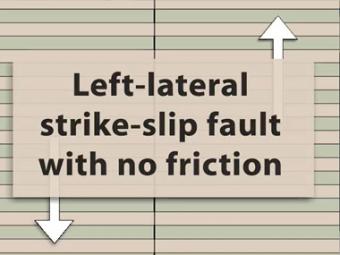
Left-lateral fault strike slip fault with little or no friction along fault contact. There is no deformation of the rock adjacent to contact. If the block opposite an observer looking across the fault moves to the left, the motion is termed left lateral.
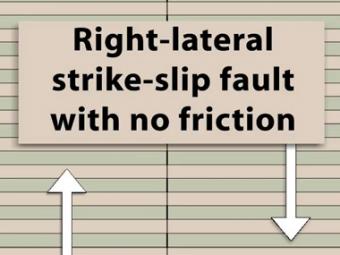
Left-lateral fault strike slip fault with low friction along fault contact. There is no deformation of the rock adjacent to contact. If the block opposite an observer looking across the fault moves to the left, the motion is termed left lateral. Example: the San Andreas Fault of California
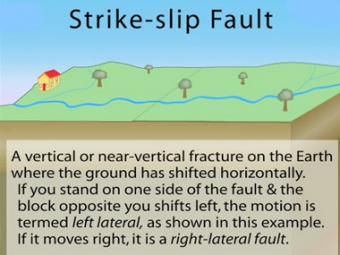
In a strike-slip fault, the movement of blocks along a fault is horizontal. The fault motion of a strike-slip fault is caused by shearing forces. Other names: transcurrent fault, lateral fault, tear fault or wrench fault. Examples: San Andreas Fault, California; Anatolian Fault, Turkey.
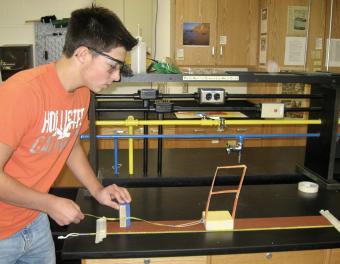
Using a block-and-sandpaper model, students collaborate in small groups to investigate how energy is stored elastically in rocks and released suddenly as an earthquake (the earthquake cycle). This activity emphasizes the role of mechanical models in understanding and testing ideas in science.
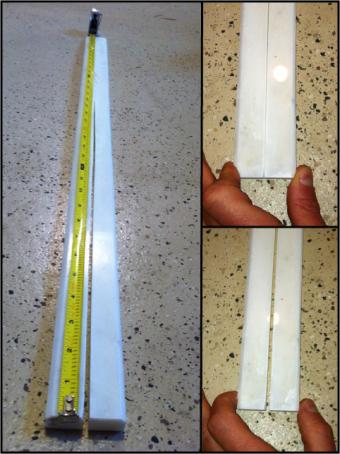
Through a demonstration lead by the teacher, the discrepant concept of rocks exhibiting elastic behavior is physically illustrated with an easily obtained, inexpensive model.